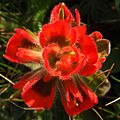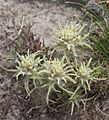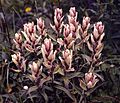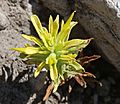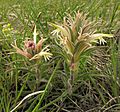Indian paintbrush facts for kids
Quick facts for kids Indian paintbrush |
|
|---|---|
 |
|
| Castilleja miniata | |
| Scientific classification |
|
| Kingdom: | Plantae |
| Clade: | Tracheophytes |
| Clade: | Angiosperms |
| Clade: | Eudicots |
| Clade: | Asterids |
| Order: | Lamiales |
| Family: | Orobanchaceae |
| Tribe: | Pedicularideae |
| Genus: | Castilleja Mutis ex L.f. |
| Species | |
|
About 200, see text |
|
| Synonyms | |
|
Euchroma Nutt. |
|
Castilleja, often called paintbrush or Indian paintbrush, is a group of about 200 different plant species. These plants can be annuals (meaning they live for one year) or perennials (living for many years). You can find them mostly in the western parts of the Americas, from Alaska all the way down to the Andes mountains. Some species also grow in northern Asia and even in northwestern Russia.
These plants are special because they are hemiparasitic. This means they get some of their food and water by attaching to the roots of other plants, like grasses and other small plants called forbs. The name Castilleja honors a Spanish botanist named Domingo Castillejo.
Contents
How Paintbrush Plants Interact with Nature
Indian paintbrush plants are an important part of their natural homes. They are eaten by the larvae (young forms) of some lepidopteran species (like moths and butterflies). For example, the caterpillars of Schinia cupes and Schinia pulchripennis eat these plants. Also, checkerspot butterflies, like Euphydryas species, enjoy them.
These plants need help to make seeds. Pollinators, like insects and even hummingbirds, visit their colorful flowers. When they do, they help the plants reproduce.
Because Castilleja plants get some nutrients from other plants, they can change how different plant species grow and compete in an area. Some Castilleja plants also have natural chemicals that protect them. Certain specialist insects can eat these plants and store the chemicals in their own bodies. This helps protect the insect larvae from animals that might want to eat them!
How New Paintbrush Species Form: Hybridization
Sometimes, different types of Castilleja plants can mix their genes together. This is called hybridization. It often happens when the plants have similar numbers of chromosomes. When they hybridize, they can even create new seeds that grow into new plants.
However, this ability to hybridize can sometimes be a problem. If a rare or endangered Castilleja species hybridizes too much with a common one, it could lose its unique genetic traits. This might make the rare species disappear over time.
Uses of Indian Paintbrush
The flowers of Indian paintbrush are actually edible! Some Native American tribes used to eat them in small amounts. They would use them as a special flavor with other fresh greens.
However, it's very important to be careful. These plants can take in and store a lot of selenium from the soil. Selenium can be poisonous if you eat too much of it. If the soil has a lot of alkaline (like baking soda), the plants might have even higher levels of selenium. So, while the flowers might offer some health benefits similar to garlic when eaten in tiny amounts, it's best to avoid eating the roots or green parts of the plant because they can be very toxic.
Symbolism of the Paintbrush Flower
The Castilleja linariifolia species, also known as the narrowleaf Indian paintbrush, is a very special plant. It is the official state flower of Wyoming.
Images for kids
-
Seeds of a possible Castilleja levisecta and Castilleja hispida hybrid.
-
Castilleja affinis, the Coast Indian paintbrush.
-
Castilleja ambigua, also called Paintbrush owl's clover.
-
Castilleja angustifolia, the Northwestern Indian paintbrush.
-
Castilleja applegatei, Applegate's Indian paintbrush.
-
Castilleja arachnoidea, the Cobwebby Indian paintbrush.
-
Castilleja attenuata, the Narrowleaf owl's clover.
-
Castilleja campestris, the vernal pool Indian paintbrush.
-
Castilleja caudata, the Port Clarence Indian paintbrush.
-
Castilleja christii, Christ's Indian paintbrush.
-
Castilleja cinerea, the Ashgray Indian paintbrush.
-
Castilleja coccinea, the Scarlet Indian paintbrush.
-
Castilleja exserta, also known as Purple owl's clover.
-
Castilleja foliolosa, the Texas Indian paintbrush.
-
Castilleja indivisa, the Entireleaf Indian paintbrush.
-
Castilleja integra, the Wholeleaf Indian paintbrush.
-
Castilleja kaibabensis, the Kaibab Indian paintbrush.
-
Castilleja lemmonii, Lemmon's Indian paintbrush.
-
Castilleja levisecta, the Golden paintbrush.
-
Castilleja linariifolia, the Narrowleaf Indian paintbrush.
-
Castilleja miniata, the Greater red Indian paintbrush.
-
Castilleja minor, the Smallflower Indian paintbrush.
-
Castilleja mollis, the Softleaf Indian paintbrush.
-
Castilleja nana, the Alpine paintbrush.
-
Castilleja neglecta, the Tiburon Indian paintbrush.
-
Castilleja occidentalis, the Western Indian paintbrush.
-
Castilleja parviflora, the Small-flowered Indian paintbrush.
-
Castilleja rubicundula, Cream sacs.
-
Castilleja septentrionalis, the Labrador Indian paintbrush.
-
Castilleja sessiliflora, the Downy Indian paintbrush.
-
Castilleja sulphurea, the Sulphur Indian paintbrush.
-
Castilleja tenuis, the Hairy owl's clover.





































